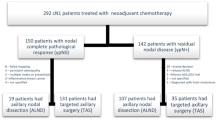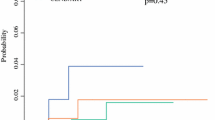Abstract
Background
For clinically node negative (N0) breast cancer patients, sentinel node (SN) biopsy (SNB) is a standard technique and complete axillary lymph node dissection (ALND) remains the standard treatment when the SN is positive. However, the American College of Surgeons Oncology Group Z0011 trial and the International Breast Cancer Study Group 23-01 trial showed that SNB without ALND can offer excellent regional control and equal survival compared with ALND for limited macrometastatic and micrometastatic SN involvement, respectively. We retrospectively evaluated axillary control rates in clinically N0 patients who had no axillary surgical treatment.
Methods
Data on 158 patients who underwent breast-conserving therapy without any axillary surgical procedure between 1994 and 2010 were extracted. The last follow-up was on May 2013, and the overall median follow-up period was 119.0 months.
Results
Of all 158 patients, 10 (6.3 %) and 3 (1.9 %) developed locoregional and axillary recurrences, respectively. The 10-year locoregional and axillary recurrence rates were 5.8 and 2.1 %, respectively. The 5- and 10-year overall survival rates were 94.0 and 84.8 %, respectively. Cases with axillary recurrence tended to have common risk factors for recurrence.
Conclusion
Even if SNB and ALND were omitted, local and regional recurrence rates were very low among clinically N0 patients and were at the same levels shown in recent trials. This suggests that at least ALND might be safely avoided in clinically N0 patients without any obvious risk factors regardless of axillary nodal status after SNB.


Similar content being viewed by others
References
Lyman GH, Giuliano AE, Somerfield MR, Benson AB 3rd, Bodurka DC, Burstein HJ, et al. American Society of Clinical Oncology guideline recommendations for sentinel lymph node biopsy in early-stage breast cancer. J Clin Oncol. 2005;23:7703–20.
Veronesi U, Viale G, Paganelli G, Zurrida S, Luini A, Galimberti V, et al. Sentinel lymph node biopsy in breast cancer: ten-year results of a randomized controlled study. Ann Surg. 2010;251:595–600. doi:10.1097/SLA.0b013e3181c0e92a.
Veronesi U, Paganelli G, Viale G, Luini A, Zurrida S, Galimberti V, et al. A randomized comparison of sentinel-node biopsy with routine axillary dissection in breast cancer. N Engl J Med. 2003;349:546–53.
Giuliano AE, Haigh PI, Brennan MB, Hansen NM, Kelley MC, Ye W, et al. Prospective observational study of sentinel lymphadenectomy without further axillary dissection in patients with sentinel node-negative breast cancer. J Clin Oncol. 2000;18:2553–9.
Bilimoria KY, Bentrem DJ, Hansen NM, Bethke KP, Rademaker AW, Ko CY, et al. Comparison of sentinel lymph node biopsy alone and completion axillary lymph node dissection for node-positive breast cancer. J Clin Oncol. 2009;27:2946–53. doi:10.1200/JCO.2008.19.5750.
Naik AM, Fey J, Gemignani M, Heerdt A, Montgomery L, Petrek J, et al. The risk of axillary relapse after sentinel lymph node biopsy for breast cancer is comparable with that of axillary lymph node dissection: a follow-up study of 4008 procedures. Ann Surg. 2004;240:462–8 discussion 468–471.
Hwang RF, Gonzalez-Angulo AM, Yi M, Buchholz TA, Meric-Bernstam F, Kuerer HM, et al. Low locoregional failure rates in selected breast cancer patients with tumor-positive sentinel lymph nodes who do not undergo completion axillary dissection. Cancer. 2007;110:723–30.
Pernas S, Gil M, Benítez A, Bajen MT, Climent F, Pla MJ, et al. Avoiding axillary treatment in sentinel lymph node micrometastases of breast cancer: a prospective analysis of axillary or distant recurrence. Ann Surg Oncol. 2010;17:772–7.
Langer I, Guller U, Viehl CT, Moch H, Wight E, Harder F, et al. Axillary lymph node dissection for sentinel lymph node micrometastases may be safely omitted in early-stage breast cancer patients: long-term outcomes of a prospective study. Ann Surg Oncol. 2009;16:3366–74. doi:10.1245/s10434-009-0660-9.
Galimberti V, Botteri E, Chifu C, Gentilini O, Luini A, Intra M, et al. Can we avoid axillary dissection in the micrometastatic sentinel node in breast cancer? Breast Cancer Res Treat. 2012;131:819–25. doi:10.1007/s10549-011-1486-2.
Krag DN, Anderson SJ, Julian TB, Brown AM, Harlow SP, Costantino JP, et al. Sentinel-lymph-node resection compared with conventional axillary-lymph-node dissection in clinically node-negative patients with breast cancer: overall survival findings from the NSABP B-32 randomised phase 3 trial. Lancet Oncol. 2010;11:927–33. doi:10.1016/S1470-2045(10)70207-2.
Giuliano AE, McCall L, Beitsch P, Whitworth PW, Blumencranz P, Leitch AM, et al. Locoregional recurrence after sentinel lymph node dissection with or without axillary dissection in patients with sentinel lymph node metastases: the American College of Surgeons Oncology Group Z0011 randomized trial. Ann Surg. 2010;252:426–32. doi:10.1097/SLA.0b013e3181f08f32 discussion 432–433.
Giuliano AE, Hunt KK, Ballman KV, Beitsch PD, Whitworth PW, Blumencranz PW, et al. Axillary dissection vs. no axillary dissection in women with invasive breast cancer and sentinel node metastasis: a randomized clinical trial. JAMA. 2011;305:569–75. doi:10.1001/jama.2011.90.
Galimberti V, Cole BF, Zurrida S, Viale G, Luini A, Veronesi P, et al. Axillary dissection versus no axillary dissection in patients with sentinel-node micrometastases (IBCSG 23-01): a phase 3 randomised controlled trial. Lancet Oncol. 2013;14:297–305. doi:10.1016/S1470-2045(13)70035-4.
Sanuki N, Takeda A, Amemiya A, Ofuchi T, Ono M, Ogata H, Yamagami R, Hatayama J, Eriguchi T, Kunieda E. Outcomes of clinically node-negative breast cancer without axillary dissection: can preserved axilla be safely treated with radiation after a positive sentinel node biopsy? Clin Breast Cancer. 2013;13(1):69–76. doi:10.1016/j.clbc.2012.09.005.
Goldhirsch A, Winer EP, Coates AS, Gelber RD, Piccart-Gebhart M, Thürlimann B, Senn HJ, Panel members. Personalizing the treatment of women with early breast cancer: highlights of the St Gallen International Expert Consensus on the Primary Therapy of Early Breast Cancer 2013. Ann Oncol. 2013;24(9):2206–23. doi:10.1093/annonc/mdt303.
Posther KE, McCall LM, Blumencranz PW, Burak WE Jr, Beitsch PD, Hansen NM, et al. Sentinel node skills verification and surgeon performance: data from a multicenter clinical trial for early-stage breast cancer. Ann Surg. 2005;242:593–9 discussion 599–602.
Krag DN, Anderson SJ, Julian TB, Brown AM, Harlow SP, Ashikaga T, et al. Technical outcomes of sentinel-lymph-node resection and conventional axillary-lymph-node dissection in patients with clinically node-negative breast cancer: results from the NSABP B-32 randomised phase III trial. Lancet Oncol. 2007;8(10):881–8.
Kim T, Giuliano AE, Lyman GH. Lymphatic mapping and sentinel lymph node biopsy in early-stage breast carcinoma: a metaanalysis. Cancer. 2006;106:4–16.
Wernicke AG, Goodman RL, Turner BC, Komarnicky LT, Curran WJ, Christos PJ, et al. A 10-year follow-up of treatment outcomes in patients with early stage breast cancer and clinically negative axillary nodes treated with tangential breast irradiation following sentinel lymph node dissection or axillary clearance. Breast Cancer Res Treat. 2011;125:893–902. doi:10.1007/s10549-010-1167-6.
Reznik J, Cicchetti MG, Degaspe B, Fitzgerald TJ. Analysis of axillary coverage during tangential radiation therapy to the breast. Int J Radiat Oncol Biol Phys. 2005;61:163–8.
Wong JS, Taghian AG, Bellon JR, Keshaviah A, Smith BL, Winer EP, et al. Tangential radiotherapy without axillary surgery in early-stage breast cancer: results of a prospective trial. Int J Radiat Oncol Biol Phys. 2008;72:866–70. doi:10.1016/j.ijrobp.2008.01.031.
Takeda A, Shigematsu N, Kondo M, Amemiya A, Kawaguchi O, Sato M, Kutsuki S, Toya K, Ishibashi R, Kawase T, Tsukamoto N, Kubo A. The modified tangential irradiation technique for breast cancer: how to cover the entire axillary region. Int J Radiat Oncol Biol Phys. 2000;46(4):815–22.
Takeda A, Shigematsu N, Ikeda T, Kawaguchi O, Kutsuki S, Ishibashi R, Kunieda E, Takeda T, Takemasa K, Ito H, Uno T, Jinno H, Kubo A. Evaluation of novel modified tangential irradiation technique for breast cancer patients using dose-volume histograms. Int J Radiat Oncol Biol Phys. 2004;58(4):1280–8.
Ohashi T, Takeda A, Shigematsu N, Fukada J, Sanuki N, Amemiya A, et al. Dose distribution analysis of axillary lymph nodes for three-dimensional conformal radiotherapy with a field-in-field technique for breast cancer. Int J Radiat Oncol Biol Phys. 2009;73:80–7. doi:10.1016/j.ijrobp.2008.04.003.
Fujimoto N, Amemiya A, Kondo M, Takeda A, Shigematsu N. Treatment of breast carcinoma in patients with clinically negative axillary lymph nodes using radiotherapy versus axillary dissection. Cancer. 2004;101:2155–63.
Zurrida S, Orecchia R, Galimberti V, Luini A, Giannetti I, Ballardini B, et al. Axillary radiotherapy instead of axillary dissection: a randomized trial. Italian Oncological Senology Group. Ann Surg Oncol. 2002;9:156–60.
Hoebers FJ, Borger JH, Hart AA, Peterse JL, Th EJ, Lebesque JV. Primary axillary radiotherapy as axillary treatment in breast-conserving therapy for patients with breast carcinoma and clinically negative axillary lymph nodes. Cancer. 2000;88:1633–42.
Cabanes PA, Salmon RJ, Vilcoq JR, Durand JC, Fourquet A, Gautier C, et al. Value of axillary dissection in addition to lumpectomy and radiotherapy in early breast cancer. Lancet. 1992;339:1245–8.
Louis-Sylvestre C, Clough K, Asselain B, Vilcoq JR, Salmon RJ, Campana F, et al. Axillary treatment in conservative management of operable breast cancer: dissection or radiotherapy? Results of a randomized study with 15 years of follow-up. J Clin Oncol. 2004;22:97–101.
Furukawa T, Kubota T, Tanino H, Oura S, Yuasa S, Murate H, et al. Chemosensitivity of breast cancer lymph node metastasis compared to the primary tumor from individual patients tested in the histoculture drug response assay. Anticancer Res. 2000;20(5C):3657–8.
Gentilini O, Veronesi U. Abandoning sentinel lymph node biopsy in early breast cancer? A new trial in progress at the European Institute of Oncology of Milan (SOUND: Sentinel node vs Observation after axillary UltraSouND). Breast. 2012;21(5):678–81. doi:10.1016/j.breast.2012.06.013.
Conflict of interest
None.
Author information
Authors and Affiliations
Corresponding author
About this article
Cite this article
Kobayashi, R., Shiraishi, K., Iwase, S. et al. Omission of axillary lymph node dissection for clinically node negative early-stage breast cancer patients. Breast Cancer 22, 657–663 (2015). https://doi.org/10.1007/s12282-014-0532-4
Received:
Accepted:
Published:
Issue Date:
DOI: https://doi.org/10.1007/s12282-014-0532-4




